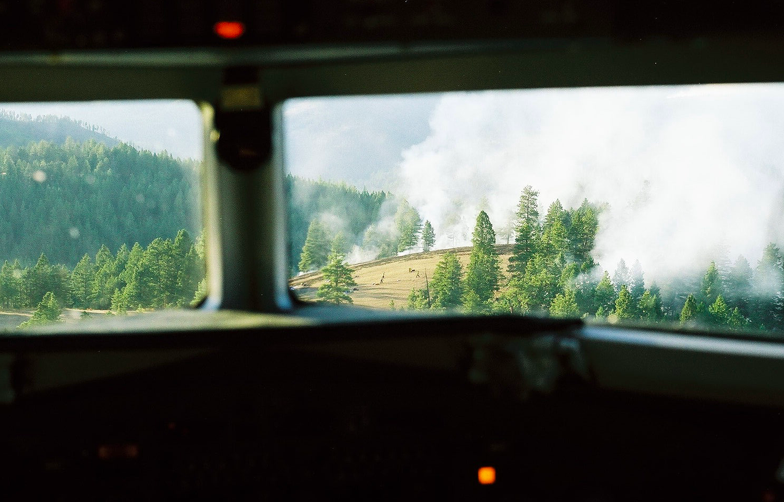
Business jets on approach into mountain bowl airports are in a low-energy, high-drag configuration, making them more susceptible to the effects of strong vertical turbulence. For example, an aircraft over the threshold at a runway perched on a precipice, such as Telluride Regional Airport’s (KTEX) Runway 9, will have the throttles retarded to idle for the landing flare. An abrupt vertical wind shear at that precipitous position puts the aircraft in a possibly unrecoverable condition due to the time required for turbofan engines to accelerate from idle to go-around power. Under FAR Part 25 airworthiness standards for transport category airplanes, the time required for engine response from flight-idle to go-around thrust can be 8 sec.
Furthermore, the winds reported by ATIS or AWOS may not accurately reflect the actual winds over the runway’s approach end and threshold. The anemometers for many of the mountain airports are located closer to midfield and will not detect the possible significant variations in wind caused by abrupt topography near the threshold.
Higher density altitudes translate into higher true airspeeds, which directly equates to much larger turn radii. For example, let’s assume that you are maneuvering to land at KTEX on a warm summer day in which the OAT is 85F. That equates to a density altitude of 12,570 feet. If your maneuvering speed is recommended to be 120 KIAS, your true airspeed under those conditions is actually 145 KTAS. Your aircraft’s turning diameter at sea level at approximately 25-30 deg. of bank would be 0.9 nm, but at this density altitude the turning diameter increases to 1.3 nm.
Always Have a Safe Way Out
The scheduled airline operators who regularly fly into these locations have very specific procedures and training programs to avoid getting caught in these traps, and to always have a guaranteed “safe way out.” Part of the safety standards require Part 121 operators to do immensely detailed studies proving adequate terrain clearance even with an inoperative engine. These detailed studies conducted by specially trained engineers consider the aircraft’s turn radius at the specific maneuvering speed, the degraded climb performance with an inoperative engine, the changes in aircraft performance during a configuration change, the effects of adverse winds on the turn radius, and even the loss of climb performance as the aircraft banks into a turn. Additionally, Part 121.445 requires special training and qualifications for PICs operating at airports determined to be unique due to surrounding terrain, obstructions, or complex approach or departure procedures.
As a former smokejumper captain, I had the privilege of delivering these elite aerial firefighters and para-cargo to the front lines of wildfires, most often in remote and rugged terrain that was even more confined than the mountain bowl airports. Prior to dropping any smokejumper, we would drop a special streamer, designed to mimic the descent rate of a smokejumper under a parachute. The long, brightly colored streamer gave us a visual indication of any turbulence in the air. We also timed the descent of the streamer to help us gauge the presence of any downdrafts. The risks to smokejumpers landing in this rugged terrain were already high enough. If there was any doubt regarding the presence of turbulence and/or downdrafts that were outside of limits, then we looked for a different drop zone.

There were countless times when we circled over a potential drop zone, carefully watching the streamers in clear air that appeared to be calm and yet they would indicate the presence of a 1,000-fpm downdraft, or a dissipating thunderstorm 30 mi. away was sending downdrafts cascading through the canyon drainages causing unseen gusty, turbulent winds.
Another part of the smokejumper mission required dropping cargo by parachute into remote locations, as well as conducting logistical support into the backcountry airstrips. The para-cargo drops are often done only a couple hundred feet above the terrain. Prior to any drop or approach into the backcountry airstrips, we--the captain, copilot and “spotter” (a hand-picked senior smokejumper who was in charge of all decisions regarding smokejumper deployment)--would evaluate the terrain, visibility, air stability, ingress route and egress route, unseen “widow-makers,” and any other topography and weather risks as we did a “high recon.” Before we commenced any descent into these tight canyons or mountain bowls, we created an escape plan in case of an engine failure. The prevailing priority was to avoid putting the aircraft into an unrecoverable situation.
Approaches into mountain bowl airports contain a synergistic mix of high threats: degraded aircraft performance due to density altitude, localized and rapidly changing weather to include significant downdrafts and windshear, approach paths that require the aircraft to descend into narrowing terrain at minimal height above terrain, aircraft at susceptible low-energy states and high drag configurations. As the accident records at these airports clearly illustrate, the risk factors are high and the safety margins are precariously thin.




